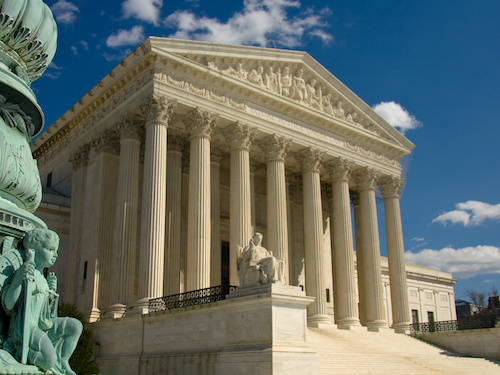“The status of the status quo is far from clear…. The Supreme Court has considered the applicability of assignor estoppel in only a handful of cases—none of them recent—and those precedents don’t provide a clear endorsement of the doctrine, let alone any clarity about its scope.”
 On Wednesday, April 21, the U.S. Supreme Court heard oral arguments in Minerva Surgical, Inc. v. Hologic, Inc., which concerns the doctrine of assignor estoppel. Generally speaking, assignor estoppel prohibits the assignor of a patent from later attacking the patent’s validity in court. Minerva argues that assignor estoppel is an ill-conceived relic of a bygone era that the Court should discard or at least substantially limit. Hologic argues that the doctrine is a bedrock part of the common law—a background against which Congress has been legislating for over a century—that the Court should preserve in full.
On Wednesday, April 21, the U.S. Supreme Court heard oral arguments in Minerva Surgical, Inc. v. Hologic, Inc., which concerns the doctrine of assignor estoppel. Generally speaking, assignor estoppel prohibits the assignor of a patent from later attacking the patent’s validity in court. Minerva argues that assignor estoppel is an ill-conceived relic of a bygone era that the Court should discard or at least substantially limit. Hologic argues that the doctrine is a bedrock part of the common law—a background against which Congress has been legislating for over a century—that the Court should preserve in full.
A Conceptually Empty Approach
A few of the questions at oral argument suggested the possibility that the justices should just leave this issue to Congress. Why not let the legislature determine whether assignor estoppel should be part of the Patent Act and, if so, what the contours of the doctrine should be? This sort of argument often has some appeal in tough cases, particularly for those who advocate for judicial restraint.
Here, the argument would go something like this: Assignor estoppel has both benefits and costs. Weighing those benefits and costs and making a subsequent value judgment about the desirability of the doctrine is a job properly left to politically accountable legislators. It not a task for unelected judges, who—to paraphrase Alexander Hamilton—have neither force nor will, but merely judgment. So, the Court should simply leave the status quo in place and apply the law. If the law needs to be changed, Congress can do it.
In this case, however, that is a conceptually empty approach. The status of the status quo is far from clear, because we lack any authoritative, objective account of the “law” courts are supposed to apply. The Supreme Court has considered the applicability of assignor estoppel in only a handful of cases—none of them recent—and those precedents don’t provide a clear endorsement of the doctrine, let alone any clarity about its scope. Many lower courts have applied the doctrine, but not always consistently, so that caselaw doesn’t provide a clear picture of how the law operates in practice either. And, while the Patent Act doesn’t mention assignor estoppel, that’s hardly determinative. The Patent Act doesn’t mention collateral estoppel or claim preclusion either, but everyone agrees those common-law doctrines apply in patent cases.
In the Eye of the Beholder
You might respond to this last point (as Minerva has) that assignor estoppel, unlike collateral estoppel, isn’t well-established enough to be considered a settled background principle against which Congress has legislated. But now we’re simply back to an argument about whether the precedent on assignor estoppel is clear enough to allow it to reach that status—which means we’re back to an argument about how to interpret the existing (indeterminate) jurisprudence on the issue.
In short, in this case, the meaning of “let’s just leave it to Congress” is in the eye of the beholder. Minerva views assignor estoppel as a misguided judicial creation that never had any rightful place in the law. So “leaving it to Congress” means overruling the doctrine and letting Congress enact some version of it into the Patent Act if Congress so chooses. Hologic views assignor estoppel as a well-established common-law principle that has been an implicit part of our patent laws for 150 years. So “leaving it to Congress” means letting the courts continue to apply it as they always have and letting Congress legislatively abolish it if Congress so chooses. The Government—appearing as amicus—views assignor estoppel as a legitimate background common-law principle when confined to its “equitable core,” but the Government believes that the Federal Circuit has been applying the doctrine too broadly. So “leaving it to Congress” means narrowing the doctrine back to its equitable core and letting Congress reweigh the competing considerations and rework the doctrine’s scope if Congress so chooses.
The Court Can’t Skirt this Issue
In other words, any proposed solution that professes to just “leave it to Congress” must implicitly take a position on what the law actually is. And a position on that question can be reached only by weighing the parties’ competing arguments about how best to reconcile the existing precedent, which itself reflects earlier courts’ (sometimes conflicting) value judgments about the costs and benefits of the doctrine and whether and when it should apply. “Judicial restraint” is not really an option in this case. The Court’s ultimate decision—however it comes out—will have to include, either explicitly or implicitly, a value judgment about the costs and benefits of assignor estoppel and how, if at all, it fits into American intellectual property law.
Image rights acquired through AdobeStock.

![[IPWatchdog Logo]](https://ipwatchdog.com/wp-content/themes/IPWatchdog%20-%202023/assets/images/temp/logo-small@2x.png)

![[[Advertisement]]](https://ipwatchdog.com/wp-content/uploads/2024/04/Patent-Litigation-2024-banner-938x313-1.jpeg)
![[Advertisement]](https://ipwatchdog.com/wp-content/uploads/2024/04/UnitedLex-May-2-2024-sidebar-700x500-1.jpg)
![[Advertisement]](https://ipwatchdog.com/wp-content/uploads/2024/04/Artificial-Intelligence-2024-REPLAY-sidebar-700x500-corrected.jpg)
![[Advertisement]](https://ipwatchdog.com/wp-content/uploads/2024/04/Patent-Litigation-Masters-2024-sidebar-700x500-1.jpg)

![[Advertisement]](https://ipwatchdog.com/wp-content/uploads/2021/12/WEBINAR-336-x-280-px.png)
![[Advertisement]](https://ipwatchdog.com/wp-content/uploads/2021/12/2021-Patent-Practice-on-Demand-recorded-Feb-2021-336-x-280.jpg)
![[Advertisement]](https://ipwatchdog.com/wp-content/uploads/2021/12/Ad-4-The-Invent-Patent-System™.png)






Join the Discussion
2 comments so far.
Marco
June 5, 2021 09:12 amI just got around to listening to the oral argument in Minerva.
With all due respect to our wonderful Supreme Court, listening to this colloquy was painful for me, as a patent lawyer who has prosecuted hundreds of patents and litigated scores of patent infringement disputes.
For me, it was like trying to listen to an eristic, cacophonic “Tower of Babel” dialog.
From what I heard, it seems unlikely this issue will resolved in a doctrinally clear way, consistent with how patent law works in the US.
Anon
April 28, 2021 06:40 pmI was following along until the end, and then realized that your beginning could be the type of “hands off” the Court could adopt (and yes, I am very often for Judicial Restraint — especially in Patent Law, which is an area of law with explicit Constitutional appointment of authority).
Rather than “conceptually empty,” the actual driver — a critical concept — IS the fact that the Constitution points to which branch should address patent law.
In that regards, the Court could write:
“Weighing those benefits and costs and making a subsequent value judgment about the desirability of the doctrine is a job properly left to politically accountable legislators. It not a task for unelected judges,“ therefore, where we see no such intrusion, and the Congress is fully able to introduce a limitation that we do not see, we refuse to write statutory law in the first instance.